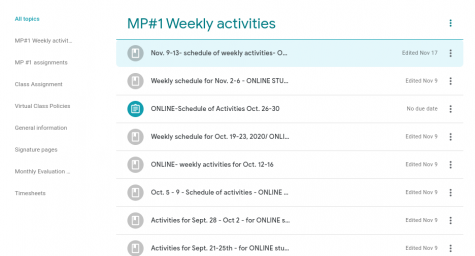Virtual schooling forces community service students to pursue alternative work
December 11, 2020
Photo by J. Kelly Brito on Unsplash
Hard at work. Because students and teachers have returned to the virtual format, many classes operate differently than they would in-person. With community service, most students cannot attend their site and are given online assignments instead.
Since students and teachers have returned to virtual learning, many classes, clubs and extracurricular activities have had to adjust or change their normal way of doing things. One of these classes that has had to do such is community service.
The community service supervisor and department chairperson Kimberly Shope has had to adapt within the past few months from starting with a virtual format, to moving to a hybrid format and now returning back virtually, while managing the sites of about 150 students.
Without in-person classes, many of these students can not continue their initially assigned community service sites.
However, for Shope, matters are much better now than they were at the beginning of the year. With more time, Shope has been able to create an alternative for students that cannot work.
“Unfortunately when the district started the year virtually for high school students, approximately half of my 150 community service students were not able to actively volunteer due to the location of their chosen site, so they participated in an online program focused on knowledge or skills learned via community service that could then be applied in the workplace, college and adult life,” Shope said.
These substitute online programs were made to benefit the students, providing them information and lessons in replacement of their community service work.
“In addition, we looked at highlighting those skills on job applications, resumes and job interviews. We finished up looking at some job related knowledge such as W-4 forms, reading pay stubs, employee benefits and insurance. The goal being that these skills and/or knowledge would ultimately benefit the seniors in the community service course like the actual experience of volunteering within our community would benefit them. I do want to note that the other half of my students were able to go to their sites during our first marking period and actively volunteer,” Shope said.
Due to school returning virtually, Shope has become somewhat used to the virtual format, going back to and updating the same online program students were using months before.
“Now during the second marking period as we have again moved to a virtual format, all but six of my students are participating in an online program for their community service course. Those six students are working remotely from home to serve their sites with digital work. The online program for the second marking period is again focused on adult life skills that should benefit these senior students. Our topics will include budgeting, saving, other personal finance topics such as buying a car, grocery shopping, renting an apartment and credit to name a few,” Shope said.
Community service students do more than just the online program. There are requirements given out daily in order for Shope to manage each student’s activity and strengthen their communication.

Through Google Classroom and Google Meets, Shope gives community service students homework assignments. Because most students cannot work at their site, Shope provides educational activities as a substitute for students. (Sydney Wilfong)
“We hold Google Meets to disseminate, review, discuss given topics and for homework assignments students are asked to watch short video clips, review documents and answer questions on given topics,” Shope said.
There are some students unlike most that have the opportunity to work remotely for their assigned community service site despite the virtual environment.
“The AAHS yearbook and Mountain Echo advisor, Mrs. Wanda Vanish, has a few students able to complete their community service assignments remotely, as well as Mrs. Kelly Detwiler [who] has a community service student supporting her virtual orchestra instruction with middle school students,” Shope said.
Yet, no matter where students are with their community service sites, issues still arise with the challenging nature of online teaching and communicating. For Shope, adjusting to the new virtual format has been no less than challenging.
“Initially, it [the challenge] was simply trying to determine how to best meet the needs of the students in this course and their expectations to be actively volunteering within our district and our community. …After deciding the direction we would take, one of my biggest challenges aside from improving my own instructional skills needed for online teaching, is managing the logistics of students online and others at a volunteer site, their assignments based on which group they were part of and having them essentially in one large class,” Shope said.
Shope understands that the struggles she faces are the same struggles students face as well. However, Shope feels that her and her students have had a steady way of communicating, becoming better as the year continues.
“I would say that student communication has improved since the start of the school year. Many students are timely in completing work, asking questions or notifying me of conflicts and tech issues. It can be overwhelming for students to manage multiple emails and Google Classroom posts daily. It is a new way of attacking education and instruction for much of the faculty and a new way of receiving instruction and learning for most students,” Shope said.
Just as communication with students works differently now, so does grading and managing assignments.
“I often had students moving between the online program and the active program in the first marking period which kept me on my toes with the switch up in assignments. I will say my grade book on Skyward looks quite different this year compared to past years,” Shope said.
Despite all the challenges and new conflicts Shope has had to face during these months, her biggest goal is to provide for the students, hoping they will gain experience through the class even if they cannot pursue their initial community service site.
“In the end, we are trying to provide the students with an opportunity to become positive, confident adults in our community when the need arises, just as we would if they could actively volunteer,” Shope said.
